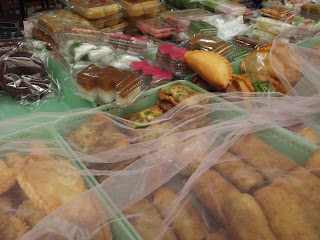.JPG) We got an early start for our request to see the original harbor, home to the shipping area of the spice trade. At first our request was met with hesitation; Yuna didn’t want to take us to ‘the dark side of Jakarta’, but we were eager to see come cultural history outside the schools and mosques. Driving to Jakarta on a Sunday proved much faster than ever before, and we found ourselves in the port area after 45 minutes. It took a while to navigate the maze-like streets near the port, but eventually we arrived at the Port Museum and Syanbandar Lookout Tower.
We got an early start for our request to see the original harbor, home to the shipping area of the spice trade. At first our request was met with hesitation; Yuna didn’t want to take us to ‘the dark side of Jakarta’, but we were eager to see come cultural history outside the schools and mosques. Driving to Jakarta on a Sunday proved much faster than ever before, and we found ourselves in the port area after 45 minutes. It took a while to navigate the maze-like streets near the port, but eventually we arrived at the Port Museum and Syanbandar Lookout Tower..JPG) The tower, built in 1839, was used for weighing goods and measuring the distance to other places from Batavia City. Surveys done in the late 1900s found it was built at a distinct angle, sort of like the Leaning Tower of Pisa.
The tower, built in 1839, was used for weighing goods and measuring the distance to other places from Batavia City. Surveys done in the late 1900s found it was built at a distinct angle, sort of like the Leaning Tower of Pisa..JPG) The tower overlooks Priok Port and is ringed with cannons to help in watching for incoming enemy ships. It was also used as a custom’s house, as the port was home to the spice, gold and slave trade starting in the 5th century.
The tower overlooks Priok Port and is ringed with cannons to help in watching for incoming enemy ships. It was also used as a custom’s house, as the port was home to the spice, gold and slave trade starting in the 5th century.We found the adjacent museum fascinating. Following the history of the port provided insight into the many cultures that had traveled through modern-day Jakarta, including traders from India, China, Portugal and the Malacca Strait. Outrigger boats appeared there 4,500 year ago and then spread to Madagascar and the Pacific Islands.
The port was crowded but felt safe. We were surprised to see other white tourists wandering around the stalls lining the harbor. Driving onto the shipping area allowed us a real treat – we bravely walked a gangplank high above the water to board a working ship. The crew allowed us to go all over the ship, which was hauling cement to Kalimantan. We felt like we had stepped back in history as we climbed around and eventually came across the Sulawesi captain, dressed only in a sarong, who wasn’t overly excited to see us on his ship. We were particularly pleased that our host summoned us the courage to board the ship as well – she was terribly frightened because she cannot swim.
.JPG)
Our host drove us back to our Jakarta hotel to meet up with
the rest of the TGC cohort. We were sad
to say goodbye, but eager to meet up with our colleagues and swap adventure
stories.
Today’s trip to the ‘dark side of Jakarta’ illuminated my
suspicion that there were areas and parts of the Indonesian culture our hosts
really didn’t want us to see. To me,
seeing how the ‘common’ people live and work is crucial to understanding where
Indonesia is as a developing country, and clarifies areas that need improvement. Again, this push and pull between traditional
and modern aspects highlighted the struggle Indonesians face as the move into
the 21st century.
.JPG)
.JPG)
.JPG)
.JPG)
.JPG)
.JPG)








.JPG)
.JPG)

.JPG)
.JPG)
.JPG)
.JPG)
.JPG)
.JPG)
.JPG)




























